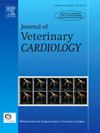犬创伤性脑损伤后疑似神经源性心肌休克
IF 1.3
2区 农林科学
Q2 VETERINARY SCIENCES
引用次数: 0
摘要
一只八岁的雄性吉娃娃在持续头部创伤后接受心脏评估。出现新的二尖瓣返流,左心扩张,收缩和舒张功能障碍。心脏尺寸和功能在12天内明显恢复正常。结果与心肌震惊一致。作者假设是头部外伤引起的神经源性心肌休克,这是一种在人类创伤性脑损伤后观察到的现象,但以前没有在狗身上报道过。本文章由计算机程序翻译,如有差异,请以英文原文为准。
Suspected neurogenic myocardial stunning following traumatic brain injury in a dog
An eight-year-old male Chihuahua was presented for a cardiac evaluation after sustaining head trauma. New mitral regurgitation, left cardiac dilation, and systolic and diastolic dysfunction were present. Normalisation of cardiac dimensions and function was apparent within 12 days. Findings were consistent with myocardial stunning. The authors hypothesise head trauma–induced neurogenic myocardial stunning, a phenomenon observed in humans after traumatic brain injury but not previously reported in dogs.
求助全文
通过发布文献求助,成功后即可免费获取论文全文。
去求助
来源期刊

Journal of Veterinary Cardiology
VETERINARY SCIENCES-
CiteScore
2.50
自引率
25.00%
发文量
66
审稿时长
154 days
期刊介绍:
The mission of the Journal of Veterinary Cardiology is to publish peer-reviewed reports of the highest quality that promote greater understanding of cardiovascular disease, and enhance the health and well being of animals and humans. The Journal of Veterinary Cardiology publishes original contributions involving research and clinical practice that include prospective and retrospective studies, clinical trials, epidemiology, observational studies, and advances in applied and basic research.
The Journal invites submission of original manuscripts. Specific content areas of interest include heart failure, arrhythmias, congenital heart disease, cardiovascular medicine, surgery, hypertension, health outcomes research, diagnostic imaging, interventional techniques, genetics, molecular cardiology, and cardiovascular pathology, pharmacology, and toxicology.
 求助内容:
求助内容: 应助结果提醒方式:
应助结果提醒方式:


